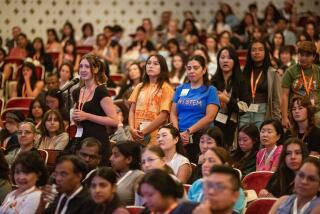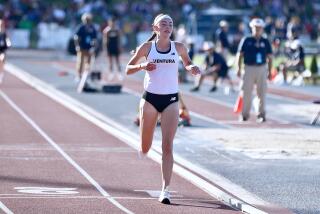Nerves are no match for these high-stakes science competitors
Over here, it was a battle of brains. Over there, it looked like a contest of dexterity.
Both qualities were in play Saturday in Pasadena as a group of young people competed at Caltech for science scholarships totaling $9,000 — and others competed for certificates and plastic Rubik’s Cubes worth $10 each.
In the hushed silence of Ramo Auditorium, high school science students in suits and ties explained their research on such matters as nanoparticles and cell fusion to a panel of 10 Caltech professors serving as judges in the annual Siemens Competition in Math, Science & Technology.
FOR THE RECORD:
Science competition: An article in the Nov. 14 California section about young people vying for scholarships and prizes in the Siemens Competition in Math, Science & Technology referred to Jeniffer Harper-Taylor as “company president.” Harper-Taylor is president of the Siemens Foundation, not Siemens Corp. —
A couple of hundred yards away in the Avery dining hall, raucous youngsters in shorts and T-shirts — and a few senior citizens — raced one another to determine who was fastest at lining up the colors on the six-sided Rubik’s Cube.
At the math-science competition, there wasn’t a papier-mache volcano in sight. High school juniors used PowerPoint displays to illustrate their graduate-school-level research.
The stakes were high. Saturday’s winners advanced to a finals competition in Washington, D.C., where next month $100,000 will be awarded by the Siemens Foundation, according to company President Jeniffer Harper-Taylor.
FOR THE RECORD:
Science competition: An article in the Nov. 14 California section about young people vying for scholarships and prizes in the Siemens Competition in Math, Science & Technology referred to Jeniffer Harper-Taylor as company president. Harper-Taylor is president of the Siemens Foundation, not Siemens Corp. —
It was nerve-racking for the students. After their strictly timed 10-minute presentations, competitors were quizzed for 12 minutes by the judges behind closed doors.
Nevertheless, Akash Krishnan, 16, and Matthew Fernandez, 17, appeared calm after they were selected to go first. Their research involved making computers recognize 57 emotions in human voices.
The Portland, Ore., pair later explained how they became intrigued by the subject after watching the 2004 science-fiction movie “I, Robot” at Akash’s house. They’ve applied for a patent on their voice-recognition system, which has already attracted the attention of call-center operators and the U.S. military, said Matthew.
Ryan Chow, 16, of San Jose and Eric Huang, 17, of Cupertino teamed up to study the effects of titanium diozide and zinc oxide nanoparticles on teeth. Sixteen-year-olds Eric Wu of Orinda and Hanna Lee of Moraga, near Oakland, examined microfluidic cell trapping for cell fusion and reprogramming.
The molecular aspects of lung cancer metastasis were the subject of research by Angela Zhang, 16, of Cupertino and Jacqueline Wang, 15, of Stanford. Lesley Chan of Hacienda Heights and Edward Huang of Yorba Linda, both 17, studied how air conditioning refrigerants and aerosol propellants break down and cause atmospheric harm.
Some competitors handled their research projects solo.
Bonnie Lei, 17, of Walnut conducted evolutionary marine biology research, discovering a previously unknown species of sea slug in the Bahamas. “I’ve always loved the beach. When I was 13, I took a college course in oceanography, and that got me started,” she explained while waiting to make her presentation.
Sean Wang, 17, of South Pasadena spent 900 hours investigating whether a recently discovered marker for liver cancer detection can also be used to identify cirrhotic livers that could become cancerous. Scott Zhuge, 17, of San Jose used a NASA space telescope to study infrared emissions in distant nebulae to measure neon and sulfur in star-forming regions.
Abhishek Venkataramana, 17, of Saratoga, near San Jose, spent a break in the competition standing on a Caltech loading dock practicing his presentation. His immunology project was aimed at identifying key target genes that might regulate such diseases as multiple sclerosis and juvenile diabetes.
Andrew Liu, 16, of Palo Alto performed bioinformatics work to identify a potential cause of organ transplant rejection.
Things were looser and noisier at the Rubik’s Cube competition. But contestants were just as intense as they raced the clock to line up the cubes’ 54 colored squares. A few even competed one-handed and blindfolded. The latter stunt required them to memorize the position of the colored squares before beginning.
Contest coordinator Michael Young, an 18-year-old freshman math and computer science student at Caltech, said fast-moving thumbs and fingers are the keys to success — but only after players learn short sequences of moves called algorithms.
Contestants ranged in age from 10 to 70. The oldest was Valerie Elson, an actress in commercials and on the stage who lives in Silver Lake. She first picked up the Rubik’s Cube a year ago.
“It’s like acting and reciting lines: If you lose your concentration, you have to start over,” Elson said.
Her best time Saturday was 1 minute 51 seconds. “I thought I was faster than that. I guess I’m an adolescent at heart,” said Elson.
Contestant Ryan Zeng of Buena Park isn’t quite an adolescent yet. The 11-year-old clocked 29 seconds. “My best time ever is 17.5 seconds. I probably didn’t get enough sleep last night.”
Like most people at Caltech on Saturday, Ryan took a scientific approach to what he was doing.
“I’d say probably your brain is more important than your hands when you do this,” Ryan said. “If you forget your moves, you can’t solve it.”
Saturday evening, officials announced the winners of the two competitions. The top Siemens prizes went to Liu’s organ-transplant project and Krishnan and Fernandez’s emotion-recognition system. Rubik’s Cube winners were Cameron Brown (12.44 seconds), Weston Mizumoto (one-handed, 17.3 seconds) and Andrew Le (blindfolded, 2 minutes 4 seconds).







